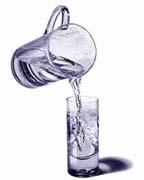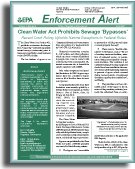Compliance
ConocoPhillips Pays $1.2 Million To Settle Clean Water Act Violations
ConocoPhillips, an international energy company, has agreed to pay a $1.2 million civil penalty to resolve alleged violations of the Clean Water Act related to over 2,000 effluent discharges from a petroleum refinery it operates in Borger, Texas, the Justice Department and Environmental Protection Agency (EPA) announced. More
EPA Issues Imminent and Substantial Endangerment Order
EPA issues an administrative order to Agrifos Fertilizer, Inc. and ExxonMobil Oil Corp. to address long-term wastewater management and prevent future endangerment to human health and the environment. More
Region reports fiscal year enforcement activities
Total fiscal year enforcement results for the Region included more than 92 million pounds of pollution reductions, more than $237 million in environmental improvements, and 674 enforcement cases concluded with facilities across Arkansas, Louisiana, New Mexico, Oklahoma and Texas.
2007 Region 6 Compliance and Enforcement Annual Results
EPA Continues Enforcement of Drinking Water Rules in Northeast Louisiana
In its continuing effort to ensure that the residents of northeast Louisiana have safe drinking water, the U.S. Environmental Protection Agency announced it has issued an additional nine administrative orders to owner-operator Jeffrey Pruett of West Monroe, Louisiana. Read more…>
TEPPCO agrees to over $2 million settlement for clean water violations
TE Products Pipeline Company, LLC and TEPPCO Crude Pipeline, LLC (collectively “TEPPCO”) will pay a $2.865 million penalty to resolve violations of the Clean Water Act.
“It is imperative that business and industry do their part to minimize the risks of oil and fuel spills,” said EPA Regional Administrator Richard E. Greene. Read more ...>
EPA orders public water supply systems in northeast Louisiana into compliance
 Based on numerous citizen complaints about the quality and safety of drinking water provided by public water supply systems in northeast Louisiana, EPA announced the issuance of six administrative orders to owner/operator Jeffrey Pruett of West Monroe, Louisiana, for violations of the federal Safe Drinking Water Act.
Based on numerous citizen complaints about the quality and safety of drinking water provided by public water supply systems in northeast Louisiana, EPA announced the issuance of six administrative orders to owner/operator Jeffrey Pruett of West Monroe, Louisiana, for violations of the federal Safe Drinking Water Act.
“We rely on a safe and abundant water supply for the health of our families and our communities,” said EPA Regional Administrator Richard E. Greene. Read more ...>
Equistar Chemicals to spend $125 million to reduce pollution
Equistar Chemicals LP, headquartered in Houston, Texas, will spend more than $125 million on pollution controls and cleanup to address a myriad of air, water and hazardous waste violations at seven petrochemical plants in Texas, Illinois, Iowa and Louisiana, the Justice Department and the Environmental Protection Agency announced today. “Business and industry play a large part in our ability to protect human health and the environment,” said EPA Regional Administrator Richard E. Greene." Read more ...>
EPA Enforcement Actions Result in Cleaner Environment
More than $1.3 billion in environmental improvements were secured and more than 181 million pounds of pollution were cut as a result of enforcement activities taken in Region 6 this year. Nationally, more than $4.9 billion in environmental improvements and 890 million pounds in pollution reductions resulted from EPA actions.
“We could not have achieved this successful level of results without the teamwork of our state environmental departments,” EPA Regional Administrator Richard E. Greene said. “Our enforcement professionals work very closely and very effectively with their state counterparts to ensure a cleaner environment and healthier communities." Read more …>

Border Center encourages compliance
The Border Compliance Assistance Center in Region 6 encourages compliance with environmental laws, especially among small- and medium-size companies, by increasing awareness of the rules for transporting hazardous waste and helping people comply.
This help is important, since Mexican law allows foreign-owned plants (maquiladoras) to import their raw materials duty-free, but requires that hazardous waste be sent back to the country of origin for disposal. Non-maquiladora plants may also ship wastes to licensed facilities in the U.S. "We want to help make this process safe, efficient and trouble-free," EPA compliance assistance coordinator Bonnie Romo said.
The Center's Web site, in English and Spanish, is easy to use and contains extensive, current information about transporting waste. In the past two years, use of the Border Center has increased by more than four-hundred percent. Tips provided on the site help minimize costs and reduce pollution by keeping delays at the border to a minimum, helping keep our borders secure and traffic moving more freely.
The Border Center, one of thirteen National Compliance Centers in the U.S., is a collaborative effort of the EPA, the National Center for Manufacturing Sciences, federal and state agencies in the border states, and the Mexican Government.
For more information:
The Border Compliance
Assistance Center ![]()
National Compliance
Assistance Centers ![]()
Air monitoring in Louisiana reveals pollution levels
 The U.S. EPA and the Louisiana Department of Environmental
Quality teamed-up for an air-quality survey of about 40 miles
along the Mississippi River in the Baton Rouge area.A bus-mounted
Trace Atmospheric Gas Analyzer (TAGA) scanned at night for
certain hydrocarbons, mercury and 1,3-butadiene. Levels above
the allowable limits were found, but not all were in the same
areas and were not all through the survey area.
The U.S. EPA and the Louisiana Department of Environmental
Quality teamed-up for an air-quality survey of about 40 miles
along the Mississippi River in the Baton Rouge area.A bus-mounted
Trace Atmospheric Gas Analyzer (TAGA) scanned at night for
certain hydrocarbons, mercury and 1,3-butadiene. Levels above
the allowable limits were found, but not all were in the same
areas and were not all through the survey area.
The survey generally confirmed the results of monitoring by the Louisiana Department, and identified areas where compliance and enforcement efforts should be applied. "We think we found three air pollutants (1,3-butadiene, vinyl-chloride and mercury) that we feel need to be more fully looked at," said John Blevins, EPA Region 6 Compliance and Enforcement Division Director.
EPA and Louisiana Department managers are still analyzing the results, and when the analysis is complete will be talking to managers of plants in areas where higher than normal pollution levels were detected.
For more information:
Trace
Atmospheric Gas Analyzer (TAGA), a self-contained mobile
lab.
TAGA
Unit Results
U.S. AND STATE OF LOUISIANA ANNOUNCE CLEAN WATER ACT AGREEMENT WITH THE CITY OF NEW IBERIA
WASHINGTON, D.C.— A comprehensive Clean Water Act settlement with the City of New Iberia was announced today by the Department of Justice, the U.S. Environmental Protection Agency, and the State of Louisiana, on behalf of the Louisiana Department of Environmental Quality. Under the settlement, the City is constructing a new sewage treatment plant expected to cost $30 million and has agreed to perform an extensive characterization, evaluation, and rehabilitation of the City’s collection system designed to eliminate sewage overflows, estimated to cost up to $20 million over the next ten years.
U.S. Department of Justice News Release
 Compliance
Assurance and Enforcement
Compliance
Assurance and Enforcement
The mission of Region 6 Compliance Assurance and Enforcement is to protect human health and the environment. Through collaboration efforts with states, local and tribal governments, other federal agencies, businesses and community groups, this office works to achieve the mission and ensure compliance with our nation's environmental requirements to get and keep our air, land and water clean. Read more >
Compliance Assistance in Region 6
Compliance assistance includes activities, tools or technical assistance that provides clear and consistent information for 1) helping business, industry and government agencies understand and meet their environmental obligations; 2) compliance assistance providers to aid the regulated community in complying with environmental regulations. Read more >
Air/Toxics Enforcement and Inspections
 The air we breathe is cleaner than it has been over the past
years due to the policies set forth through laws and regulations
that were enforced at EPA. Since 1995, violators of
the Clean
Air Act (CAA), the Toxic
Substances Control Act (TSCA) and the Asbestos
Hazard Emergency Response Act (AHERA)have been provided
options to return to compliance through compliance incentives,
compliance assistance and a strong enforcement program.
Air quality has improved significantly because of environmental
compliance and industry controls. This branch serves
as the principle point of contact between EPA, State and local
agencies on matters concerning air pollution enforcement. Read
more >
The air we breathe is cleaner than it has been over the past
years due to the policies set forth through laws and regulations
that were enforced at EPA. Since 1995, violators of
the Clean
Air Act (CAA), the Toxic
Substances Control Act (TSCA) and the Asbestos
Hazard Emergency Response Act (AHERA)have been provided
options to return to compliance through compliance incentives,
compliance assistance and a strong enforcement program.
Air quality has improved significantly because of environmental
compliance and industry controls. This branch serves
as the principle point of contact between EPA, State and local
agencies on matters concerning air pollution enforcement. Read
more >
EPA's enforcement and compliance assurance program is focused on producing measurable results to protect public health and the environment. The program has always tracked traditional measures, such as the number of inspections. Recently, the program has implemented the National Performance Measures Strategy which, while continuing some reporting on traditional activity, or output measures, increases the number of outcome measures (e.g., pounds of pollutants reduced as a result of an enforcement action). The accomplishments of the enforcement and compliance assurance program are reported in a variety of documents. Read more >
Supplemental Environmental Projects
 A Supplement Environmental Project (SEP) is part of an enforcement
settlement connected with the violation of an environmental
statutory or regulatory requirement. As part of the enforcement
settlement, a violator voluntarily agrees to undertake an
environmentally beneficial project in exchange for a reduction
in the penalty. A SEP furthers EPA's goal of protecting and
enhancing the public health and the environment, and does
not include the activities a violator must take to return
to compliance with the law. Read
more >
A Supplement Environmental Project (SEP) is part of an enforcement
settlement connected with the violation of an environmental
statutory or regulatory requirement. As part of the enforcement
settlement, a violator voluntarily agrees to undertake an
environmentally beneficial project in exchange for a reduction
in the penalty. A SEP furthers EPA's goal of protecting and
enhancing the public health and the environment, and does
not include the activities a violator must take to return
to compliance with the law. Read
more >
Superfund: Finding Those Responsible
The companies or people that EPA determines are responsible for the clean up at Superfund sites are called "Potentially Responsible Parties" or "PRPs." EPA conducts a PRP search at each Superfund site to find the potentially responsible parties. EPA's primary goal in conducting the PRP search is to identify all of the PRPs at a particular Superfund site. Read more >

Resources
- Region 6 Public Information Center (800) 887-6063
- About Region 6
- Federal Register
- Contact Us
- Freedom of Information Act
- Employee Access
Additional Information
Air, Agriculture, Brownfields, Cleanup, Ecosystems, Enforcement, Environmental Justice, Grants, Laboratory, Pesticides, Superfund, Tribal, Training, Waste, Water, more topics
![[logo] US EPA](https://webarchive.library.unt.edu/eot2008/20080916224600im_/http://www.epa.gov/epafiles/images/logo_epaseal.gif)
